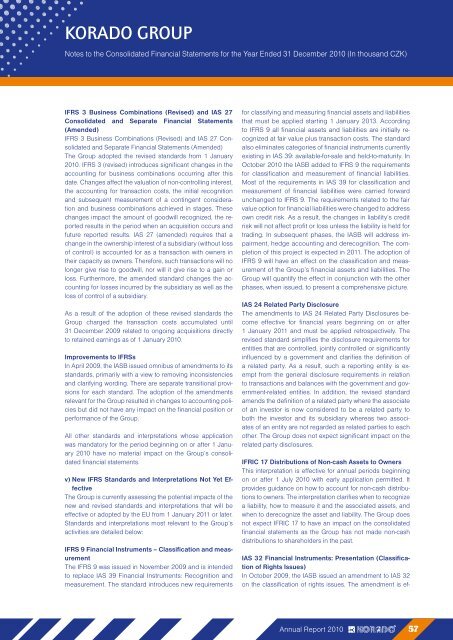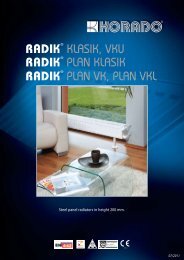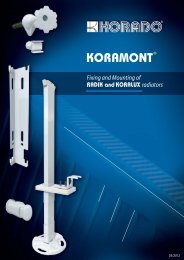ANNUAL REPORT - KORADO, as
ANNUAL REPORT - KORADO, as
ANNUAL REPORT - KORADO, as
Create successful ePaper yourself
Turn your PDF publications into a flip-book with our unique Google optimized e-Paper software.
<strong>KORADO</strong> GROUP<br />
Notes to the Consolidated Financial Statements for the Year Ended 31 December 2010 (In thousand CZK)<br />
IFRS 3 Business Combinations (Revised) and IAS 27<br />
Consolidated and Separate Financial Statements<br />
(Amended)<br />
IFRS 3 Business Combinations (Revised) and IAS 27 Consolidated<br />
and Separate Financial Statements (Amended)<br />
The Group adopted the revised standards from 1 January<br />
2010. IFRS 3 (revised) introduces significant changes in the<br />
accounting for business combinations occurring after this<br />
date. Changes affect the valuation of non-controlling interest,<br />
the accounting for transaction costs, the initial recognition<br />
and subsequent me<strong>as</strong>urement of a contingent consideration<br />
and business combinations achieved in stages. These<br />
changes impact the amount of goodwill recognized, the reported<br />
results in the period when an acquisition occurs and<br />
future reported results. IAS 27 (amended) requires that a<br />
change in the ownership interest of a subsidiary (without loss<br />
of control) is accounted for <strong>as</strong> a transaction with owners in<br />
their capacity <strong>as</strong> owners. Therefore, such transactions will no<br />
longer give rise to goodwill, nor will it give rise to a gain or<br />
loss. Furthermore, the amended standard changes the accounting<br />
for losses incurred by the subsidiary <strong>as</strong> well <strong>as</strong> the<br />
loss of control of a subsidiary.<br />
As a result of the adoption of these revised standards the<br />
Group charged the transaction costs accumulated until<br />
31 December 2009 related to ongoing acquisitions directly<br />
to retained earnings <strong>as</strong> of 1 January 2010.<br />
Improvements to IFRSs<br />
In April 2009, the IASB issued omnibus of amendments to its<br />
standards, primarily with a view to removing inconsistencies<br />
and clarifying wording. There are separate transitional provisions<br />
for each standard. The adoption of the amendments<br />
relevant for the Group resulted in changes to accounting policies<br />
but did not have any impact on the financial position or<br />
performance of the Group.<br />
All other standards and interpretations whose application<br />
w<strong>as</strong> mandatory for the period beginning on or after 1 January<br />
2010 have no material impact on the Group’s consolidated<br />
financial statements.<br />
v) New IFRS Standards and Interpretations Not Yet Effective<br />
The Group is currently <strong>as</strong>sessing the potential impacts of the<br />
new and revised standards and interpretations that will be<br />
effective or adopted by the EU from 1 January 2011 or later.<br />
Standards and interpretations most relevant to the Group’s<br />
activities are detailed below:<br />
IFRS 9 Financial Instruments – Cl<strong>as</strong>sification and me<strong>as</strong>urement<br />
The IFRS 9 w<strong>as</strong> issued in November 2009 and is intended<br />
to replace IAS 39 Financial Instruments: Recognition and<br />
me<strong>as</strong>urement. The standard introduces new requirements<br />
for cl<strong>as</strong>sifying and me<strong>as</strong>uring financial <strong>as</strong>sets and liabilities<br />
that must be applied starting 1 January 2013. According<br />
to IFRS 9 all financial <strong>as</strong>sets and liabilities are initially recognized<br />
at fair value plus transaction costs. The standard<br />
also eliminates categories of financial instruments currently<br />
existing in IAS 39: available-for-sale and held-to-maturity. In<br />
October 2010 the IASB added to IFRS 9 the requirements<br />
for cl<strong>as</strong>sification and me<strong>as</strong>urement of financial liabilities.<br />
Most of the requirements in IAS 39 for cl<strong>as</strong>sification and<br />
me<strong>as</strong>urement of financial liabilities were carried forward<br />
unchanged to IFRS 9. The requirements related to the fair<br />
value option for financial liabilities were changed to address<br />
own credit risk. As a result, the changes in liability’s credit<br />
risk will not affect profit or loss unless the liability is held for<br />
trading. In subsequent ph<strong>as</strong>es, the IASB will address impairment,<br />
hedge accounting and derecognition. The completion<br />
of this project is expected in 2011. The adoption of<br />
IFRS 9 will have an effect on the cl<strong>as</strong>sification and me<strong>as</strong>urement<br />
of the Group’s financial <strong>as</strong>sets and liabilities. The<br />
Group will quantify the effect in conjunction with the other<br />
ph<strong>as</strong>es, when issued, to present a comprehensive picture.<br />
IAS 24 Related Party Disclosure<br />
The amendments to IAS 24 Related Party Disclosures become<br />
effective for financial years beginning on or after<br />
1 January 2011 and must be applied retrospectively. The<br />
revised standard simplifies the disclosure requirements for<br />
entities that are controlled, jointly controlled or significantly<br />
influenced by a government and clarifies the definition of<br />
a related party. As a result, such a reporting entity is exempt<br />
from the general disclosure requirements in relation<br />
to transactions and balances with the government and government-related<br />
entities. In addition, the revised standard<br />
amends the definition of a related party where the <strong>as</strong>sociate<br />
of an investor is now considered to be a related party to<br />
both the investor and its subsidiary where<strong>as</strong> two <strong>as</strong>sociates<br />
of an entity are not regarded <strong>as</strong> related parties to each<br />
other. The Group does not expect significant impact on the<br />
related party disclosures.<br />
IFRIC 17 Distributions of Non-c<strong>as</strong>h Assets to Owners<br />
This interpretation is effective for annual periods beginning<br />
on or after 1 July 2010 with early application permitted. It<br />
provides guidance on how to account for non-c<strong>as</strong>h distributions<br />
to owners. The interpretation clarifies when to recognize<br />
a liability, how to me<strong>as</strong>ure it and the <strong>as</strong>sociated <strong>as</strong>sets, and<br />
when to derecognize the <strong>as</strong>set and liability. The Group does<br />
not expect IFRIC 17 to have an impact on the consolidated<br />
financial statements <strong>as</strong> the Group h<strong>as</strong> not made non-c<strong>as</strong>h<br />
distributions to shareholders in the p<strong>as</strong>t.<br />
IAS 32 Financial Instruments: Presentation (Cl<strong>as</strong>sification<br />
of Rights Issues)<br />
In October 2009, the IASB issued an amendment to IAS 32<br />
on the cl<strong>as</strong>sification of rights issues. The amendment is ef-<br />
Annual Report 2010 57





